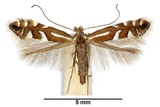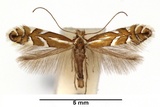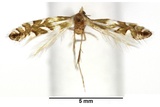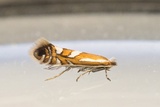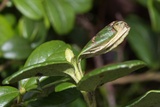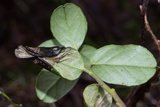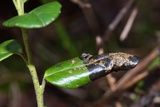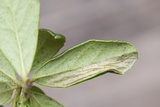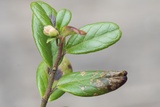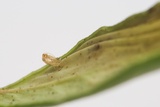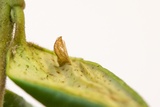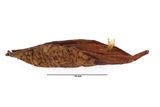Phyllonorycter junoniella (Zeller, 1846) Species
Last modified: Dec. 10, 2025, 5:16 p.m.
A rare and very local species in Belgium, nowadays confined to the eastern part of the country.
Details
- Classification
- Family: Gracillariidae > Subfamily: Lithocolletinae > Genus: Phyllonorycter > Species: Phyllonorycter junoniella
- Vernacular names
- Vossenbesvouwmot (NL), Upland midget (EN), Preiselbeer-Miniermotte (DE)
- Synonyms
- Phyllonorycter vacciniella (Stainton, 1855)
- First mention in Belgium
- Janmoulle E. 1952c. Notes sur les Microlépidoptères de Belgique. IV. Quelques espèces nouvelles pour la faune belge ou peu connues. — Bulletin du Musée royal d'Histoire naturelle de Belgique 28(68): 1–8. On page 8. view page
- Status
-
Native
Distribution
Imago
Head dark brown; forewing ground colour golden brown with white pattern consisting of a rather long, not edged, basal line, four costal and three dorsal striae of which the outer one is sometimes inconspicuous; a patch of dark brown to blackish scales in the apical area.
Caterpillar
Greenish.
Mine
A rather large tentiform mine on the underside of a leaf, sometimes occupying the entire leaf area. Spinning in the mine causes the leaf margins to contract, thus strongly contorting the mine. Two to three strong longitudinal folds. At first the mine is green, but it turns to dark brown in the last stages. From the upperside the mine is visible as a series of brown or purplish brown spots.
See also gracillariidae.net and bladmineerders.be.
Bionomics
The last instar pupates inside the mine. The species hibernates in the pupal stage.
Flight periods
It is unclear whether there is just one or there are two generations a year. Adults have been observed from April till October.
Observed on
- Host plant (species):
- Vaccinium vitis-idaea
A monophagous species, living only on Vaccinium vitis-idaea.
Habitat
Moist wetlands, peatlands, where the larval host plant grows.
